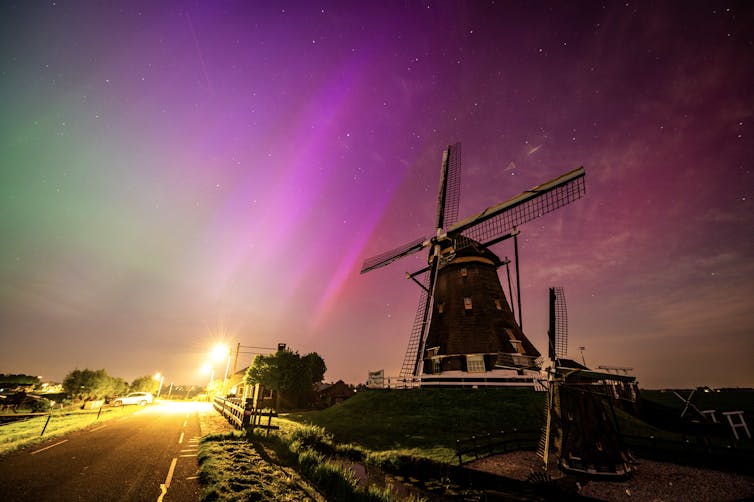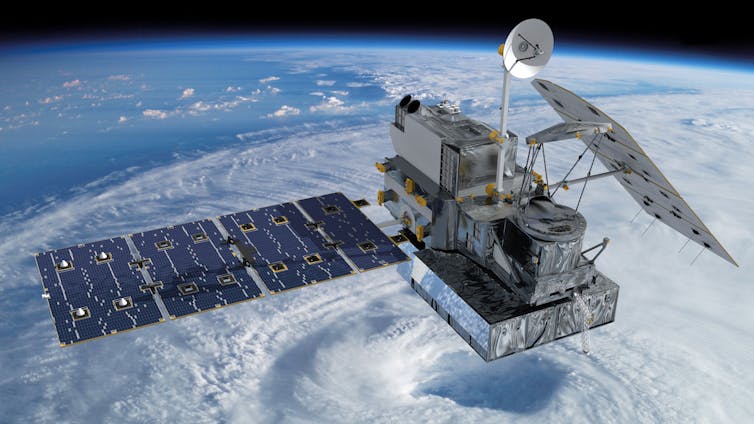At the weekend, millions of people around the world were treated to a mesmerising display of the aurora borealis and aurora australis, better known as the northern and southern lights. The lights, usually seen in crown-like regions surrounding the Earth’s poles, were pushed to mid-latitudes by heightened activity from the Sun.
The same geomagnetic storms causing the auroras can cause havoc with our planet’s human-made infrastructure. These storms, caused by high energy particles from the Sun hitting our atmosphere, have the potential to knock out electrical grids and satellites. So what were the impacts of this recent burst of stormy space weather?
Around May 8, an active region of the Sun exploded, flinging a billion-tonne cloud of magnetised and electrically charged material known as a coronal mass ejection (CME) towards the Earth. This turned out to be the first of several successive CMEs, which later merged to form a single, massive structure.
This crashed into our planet’s magnetosphere, the region of space near Earth that is dominated by the terrestrial magnetic field. As sub-atomic particles from the CME are funnelled downward, channels of electrical current flowing through part of the atmosphere known as the ionosphere, are intensified.
Apart from triggering the auroral displays, this can cause powerful magnetic fluctuations at the Earth’s surface. As a result, electrical currents can flow through power grids, pipelines and railway lines, potentially interfering with normal operations.

The sub-atomic particles from the CME can cause damage to the solar panels and electronics of satellites. On Saturday, Elon Musk said that his company SpaceX’s Starlink internet satellites were “under a lot of pressure,” because of the storm, “but holding up so far”.
The disturbances in the ionosphere were compounded by a series of bright eruptions called “flares” on the Sun that poured high energy radiation across the Earth’s sunlit face. Flare activity is associated with radio blackouts that can interfere with high-frequency radio communications, such as those required by aircraft on trans-oceanic flights. There are indications that the storm caused some disruption on transatlantic flights, but these reports are still being assessed.
Shawn Dahl, service coordinator for the Space Weather Prediction Center at the National Oceanic and Atmospheric Administration (NOAA) in Colorado told US National Public Radio that power grid operators had been busy “working to keep proper, regulated current flowing without disruption”.
He also added that some GPS systems had struggled to lock locations and had offered incorrect positions. These GPS problems appear to have caused disruption to navigational systems in farming equipment in the US. Many tractors use GPS to plant precise rows in a field, avoid gaps and overlaps. The problems happened during the height of planting season in the midwest and Canada.
Some of this may sound a bit like a Hollywood disaster movie. Yet, while the GPS problems caused significant disruption in agriculture, impacts do not appear to have been widespread across the Earth. For many or most, life seems to have carried on, regardless. How come?
Awareness and preparedness certainly helped. What we just experienced was, without question, an unusually strong space weather event. It’s early days and scientists will be analysing the storm of May 2024 for years to come. However, early indications are that last weekend’s geomagnetic storm was the most powerful since the “Halloween storm” of October 2003. Beyond the beautiful lights in the sky, the negative impacts of the 2024 storm aren’t yet completely clear.
At this stage, it doesn’t look like there were any catastrophic failures, but infrastructure operators will be taking stock to understand if, and how, their systems were affected. Behind the scenes, national agencies such as NOAA and the Met Office in the UK were monitoring the activity, issuing forecasts and alerts to interested parties, and liaising with experts and governments. In response, infrastructure operators took steps to ensure the continuity of services and safeguard their equipment.

Even bigger storms
However, what we’ve just experienced wasn’t the biggest such event ever seen. That honour goes to the “Carrington Event” of September 1859, in which a massive CME (or most likely a pair of CMEs) triggered a huge geomagnetic storm that pushed the aurora borealis as far south as the Caribbean and induced such powerful currents in copper telegraph lines that at least one operator suffered a severe electric shock – though he lived.
By some metrics, the Carrington event was two to three times more powerful than the storm we have just witnessed. Such massive events are rare, probably occurring once every couple of hundred years, in contrast to the May 2024 storm which was of a scale seen once every couple of decades.
Human technology is able to cope with relatively powerful space weather events, but modern technologies and infrastructure have never experienced anything like the Carrington event. This is why researchers strive to better understand space weather and work with agencies and government to predict and mitigate its impact on our society and develop better forecasting tools.


